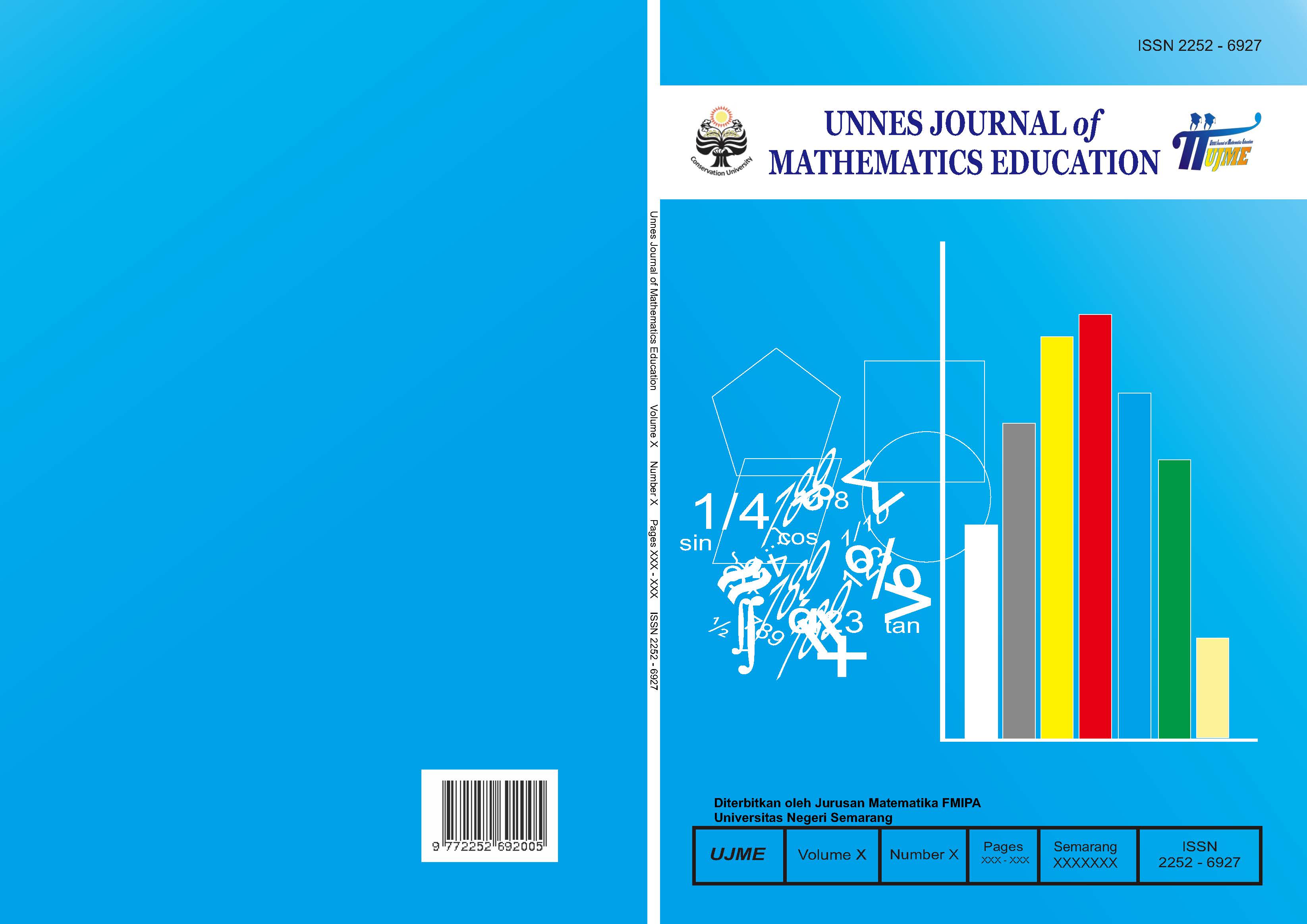Analisis Kemampuan Koneksi Matematika Siswa Kelas VIII pada Model Eliciting Activities (MEA) Ditinjau dari Gaya Kognitif
##plugins.themes.academic_pro.article.main##
Abstract
Tujuan penelitian ini (1) mengetahui apakah kemampuan koneksi matematika siswa kelas VIII pada MEA lebih baik daripada kemampuan koneksi matematika siswa pada model ekspositori, (2) mengetahui apakah terdapat perbedaan kemampuan koneksi matematika siswa FD dan FI, dan (3) mendeskripsikan kemampuan koneksi matematika pada MEA berdasarkan gaya kognitif. Jenis penelitian ini adalah mixed method dengan populasi siswa kelas VIII. Kelas sampel terdiri atas VIIIA dan VIIIB. Subjek penelitian terdiri dari 6 siswa. Teknik pengumpulan data meliputi observasi, dokumentasi, tes koneksi matematika, GEFT, dan wawancara. Hasil penelitian menunjukkan bahwa (1) kemampuan koneksi matematika siswa pada MEA lebih baik dibandingkan pada ekspositori; (2) terdapat perbedaan kemampuan koneksi matematika siswa FD dan FI; (3) siswa FD mampu mencari dan memahami hubungan antar topik dan antara topik matematika dengan topik di luar matematika, serta menerapkan matematika dalam kehidupan, tetapi siswa FD tidak mampu menerapkan matematika dalam disiplin ilmu lain, tidak mampu memahami representasi, dan tidak mampu sampai kurang mampu mencari hubungan satu prosedur dengan prosedur lain; sedangkan, siswa FI mampu mencari dan memahami hubungan antar topik dan antara topik matematika dengan topik di luar matematika, memahami representasi, menerapkan matematika dalam bidang lain dan kehidupan, dan mencari hubungan satu prosedur dengan prosedur lain.
The purpose of this study were (1) determine whether the mathematical connection ability of eighth grader student on MEA is better than the mathematical connection ability on expository, (2) determine whether there are differences mathematical connection ability of FD and FI students, and (3) describe the mathematical connection ability on MEA based on cognitive style. This study is mix method with the population were eighth grader students. The sample class were VIIIA and VIIIB. Subjects consisted of 6 students. Data collection techniques including observation, documentation, mathematical connection test, GEFT, and interviews. The results showed that (1) the mathematical connection ability of student on MEA is better than on expository; (2) there are differences in mathematical connection ability of students FD and FI; (3) students FD are able to find and understand the relationships between topics and between mathematical topic and outside mathematical topic, and apply mathematics in life, but students FD unable to apply mathematics in other disciplines, unable to understand the representation, and not able to less able to find the relationship of the procedure with another procedure; whereas, students FI were able to find and understand the relationships between topics and between mathematical topic and outside mathematical topic, understand representation, applying mathematics in other disciplines and life, and find the relationship of the procedure with another procedure.
##plugins.themes.academic_pro.article.details##
References
Cataloglu, E. & S. Ates. 2014. The Effect of Cognitive Styles on Naïve Impetus Theory Application Degrees of Pre-Service Sciences Teachers. International Journal of Science and Mathematics Education. 12: 699-719.
Chamberlin, S. A. & S. M. Moon. 2008. How Does the Problem Based Learning Approach Compare to the Model-Eliciting Activity Approach in Mathematics? International Journal for Mathematics Teaching and Learning. Tersedia di http://cimt.plymouth.ac.uk. [diakses 3 Januari 2016].
Eric, C.C.M. 2008. Using Model-Eliciting Activities for Primary Mathematics Classrooms. The Mathematics Educators. 11(1): 47-66.
Gilat, T. & M. Amit. 2013. Exploring Young Students Creativity: the Effect of Model Eliciting Activities. PNA. 8(2): 51-59.
Guisande, M. A. et al. 2007. Field Dependence-Independence (FDI) Cognitive Style: An Analysis of Attentional Functioning. Psicotema. 19(4): 572-577.
Oyenkuru, B. U. 2015. Field Dependence-Field Independence Cognitive Style, Gender, Career Choice and Academic Achievement of Secondary School Students in Emohua Local Government Area of Rivers State. Journal of Education and Practice. 6(10): 76-85.
Rifqiyana, L., Masrukan, & Susilo, B.E. 2016. Analisis Kemampuan Berpikir Kritis Siswa Kelas VIII dengan Model Pembelajaran 4K Ditinjau dari Gaya Kognitif Siswa. Unnes Journal Mathematics Education (UJME). 5(1): 40-46.
Rohendi, D. 2012. Developing E-Learning Based on Animation Content for Improving Mathematical Connection Abilities in High School Students. IJCSI International Journal of Computer Science Issues. 9(1): 1-5.
Saminanto & Kartono. 2015. Analysis of Mathematical Connection Ability in Linear Equation with One Variable Based On Connectivity Theory. International Journal of Education and Research. 3(4): 259-270.
Sugiyono. 2013. Metode Penelitian Kombinasi. Bandung: Alfabeta.
Sumarmo, U. 2012. Pendidikan Karakter serta Pengembangan Berfikir dan Disposisi Matematik dalam Pembelajaran Matematika. Makalah dipresentasikan pada Seminar Pendidikan Matematika, NTT, 25 Februari 2012.
Ulya, H., Kartono, & A. Retnoningsih. 2014. Analisis Kemampuan Pemecahan Masalah Matematika SMP Ditinjau dari Gaya Kognitif Siswa. Tesis. Universitas Negeri Semarang.
Ulya, H., Kartono, & A. Retnoningsih. 2014. Analysis of Mathematics Problem Solving Ability of Junior High School Students Viewed from Students’ Cognitive Style. International Conference on Mathematics, Science, and Education (ICMSE).
Vendiagrys, L, I. Junaedi, & Masrukan.2015. Analisis Kemampuan Pemecahan Masalah Matematika Soal Setipe TIMSS Berdasarkan Gaya Kognitif Siswa Pada Pembelajaran Model Problem Based Learning. Unnes Journal of Mathematics Education Research (UJMER). 4(1):34-41.
Woolfolk, A. 2001. Educational Psychology. Boston: Allyn and Bacon.
Yasa, A. et al. 2013. Pengaruh Penendidikan Matematika Realistik dan Gaya Kognitif terhadap Prestasi Belajar Matematika Siswa. e-Journal Program Pascasarjana Universitas Pendidikan Ganesha Program Studi Matematika.2: 1-11.
Yu, S. & C-K. Chang. 2011. What Did Taiwan Mathematics Teachers Think of Model Eliciting Activities and Modelling Teaching dalam Kaiser, G. et al. (Ed.), Trends in Teaching and Learning of Mathematics Modelling, International Perspectives on the Teaching and Learning Mathematical Modelling. New York: Springer. Hlm. 147-156
